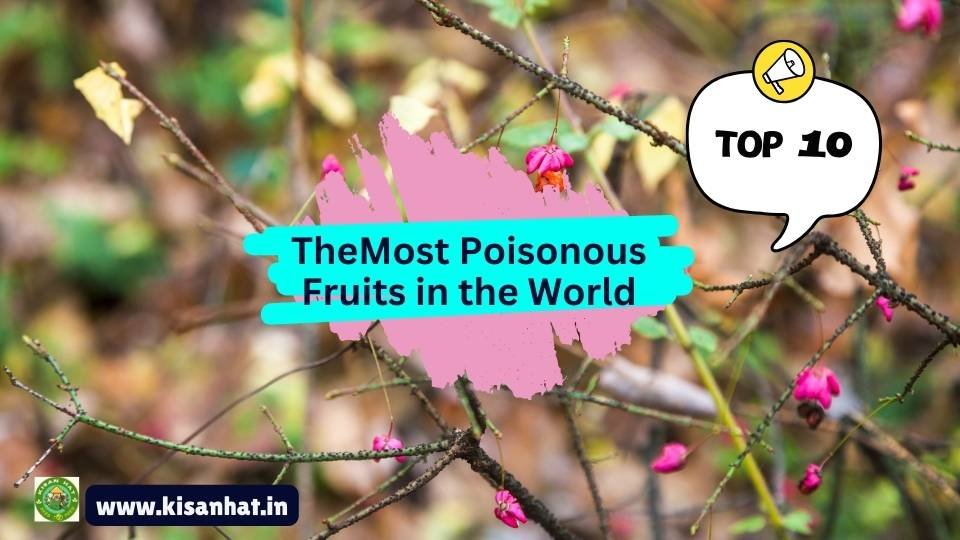While fruits are generally considered healthy and nutritious, there are a few exceptions that you should be aware of. Some fruits contain toxic compounds that can be harmful or even deadly if consumed in large quantities. In this article, we will explore the top 10 most poisonous fruits in the world, their toxic components, and the potential risks they pose.
The Top 10 Most Poisonous Fruits in the World
1. Ackee
Ackee is a tropical fruit native to West Africa, but it is also grown in other parts of the world. The fruit itself is safe to eat when it is fully ripe and the arils (the edible part) are separated from the toxic seeds and membrane. However, if consumed before ripening or if the seeds and membrane are ingested, ackee can cause a serious condition called Jamaican Vomiting Sickness. Symptoms include vomiting, seizures, and even death.
2. Manchineel
The manchineel tree, native to the Caribbean and parts of Florida, produces a small green fruit that resembles an apple. However, this fruit is extremely toxic and should never be consumed. Every part of the manchineel tree contains a potent toxin called phorbol, which can cause severe burns, blistering of the skin, and even blindness if it comes into contact with the eyes.
3. Strychnine Tree
The Strychnine tree, also known as the Nux vomica tree, produces small orange fruits that contain the deadly poison strychnine. Ingesting the seeds of this fruit can lead to muscle spasms, convulsions, and respiratory failure. Due to its toxicity, strychnine has been used as a pesticide and in the past, it was even used as a method of execution.
4. Death Apple
The Death Apple, also known as the Manzanillo, is a highly toxic fruit that is native to Central America. It resembles a small apple and contains a potent toxin called phorbol, similar to the manchineel tree. Ingesting this fruit can cause severe gastrointestinal symptoms, such as vomiting and diarrhea, as well as respiratory distress and even death.
5. Oleander
Oleander is a beautiful flowering shrub that produces small fruits that resemble elongated capsules. However, these fruits are highly toxic and should never be consumed. The entire plant, including the fruits, contains toxic compounds called cardiac glycosides, which can cause irregular heart rhythms, seizures, and even death if ingested.
6. Rosary Pea
The Rosary Pea, also known as Jequirity bean, is a small red and black seed that is often used in jewelry making. However, this seed is highly poisonous due to the presence of a toxin called abrin. Ingesting even a small amount of this seed can cause severe gastrointestinal symptoms, organ failure, and ultimately, death.
7. Yew Berry
The Yew Berry, which is the fruit of the yew tree, may look harmless, but it is actually highly toxic. The seeds of this fruit contain a toxic compound called taxine, which can cause cardiac arrest and death if ingested. It’s important to note that the flesh of the fruit is not poisonous, but the seeds should be avoided at all costs.
8. English Yew
The English Yew, also known as Taxus baccata, is a common evergreen tree in Europe. While the flesh of the fruit is safe to eat, the seeds contain high amounts of taxine, a toxic alkaloid. Ingesting these seeds can lead to symptoms such as dizziness, tremors, and in severe cases, heart failure.
9. White Baneberry
The White Baneberry, also known as Doll’s Eyes, is a small white fruit that resembles a pair of eyes. Despite its innocent appearance, this fruit is highly toxic. The entire plant, including the fruit, contains cardiogenic toxins that can cause cardiac arrest and death if ingested.
10. Bloodroot
Bloodroot is a flowering plant that produces small red fruits. While the fruit itself is not toxic, the sap of the plant contains a toxic compound called sanguinarine. Ingesting the sap can lead to symptoms such as nausea, vomiting, and in severe cases, respiratory failure.
Conclusion
It’s important to remember that while these fruits are highly toxic, they are not commonly found in supermarkets or consumed by the general population. However, it’s still crucial to be aware of their potential dangers and avoid them at all costs. When it comes to fruits, it’s always best to stick to the well-known and safe varieties that provide essential vitamins and nutrients without any risks.



